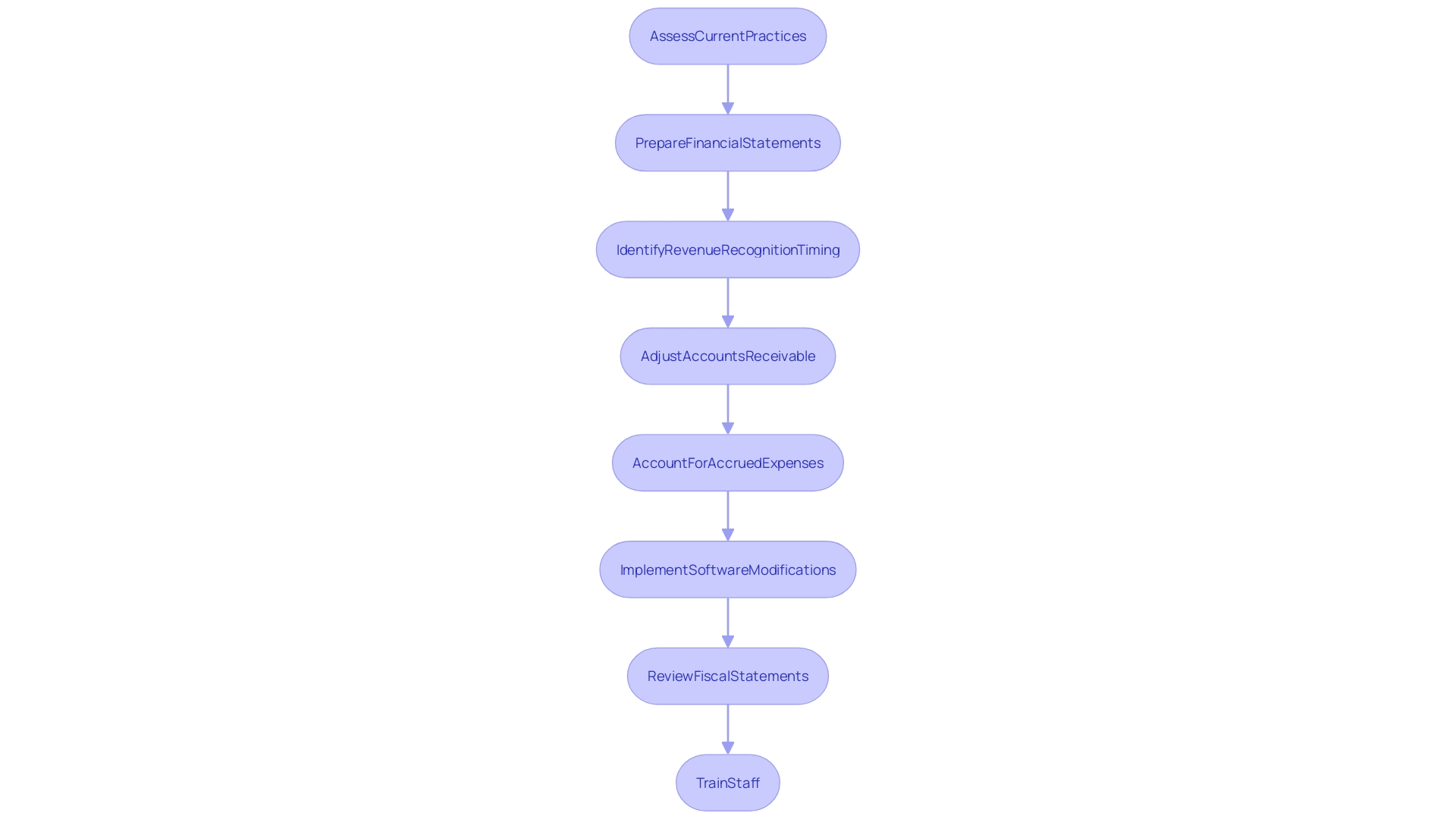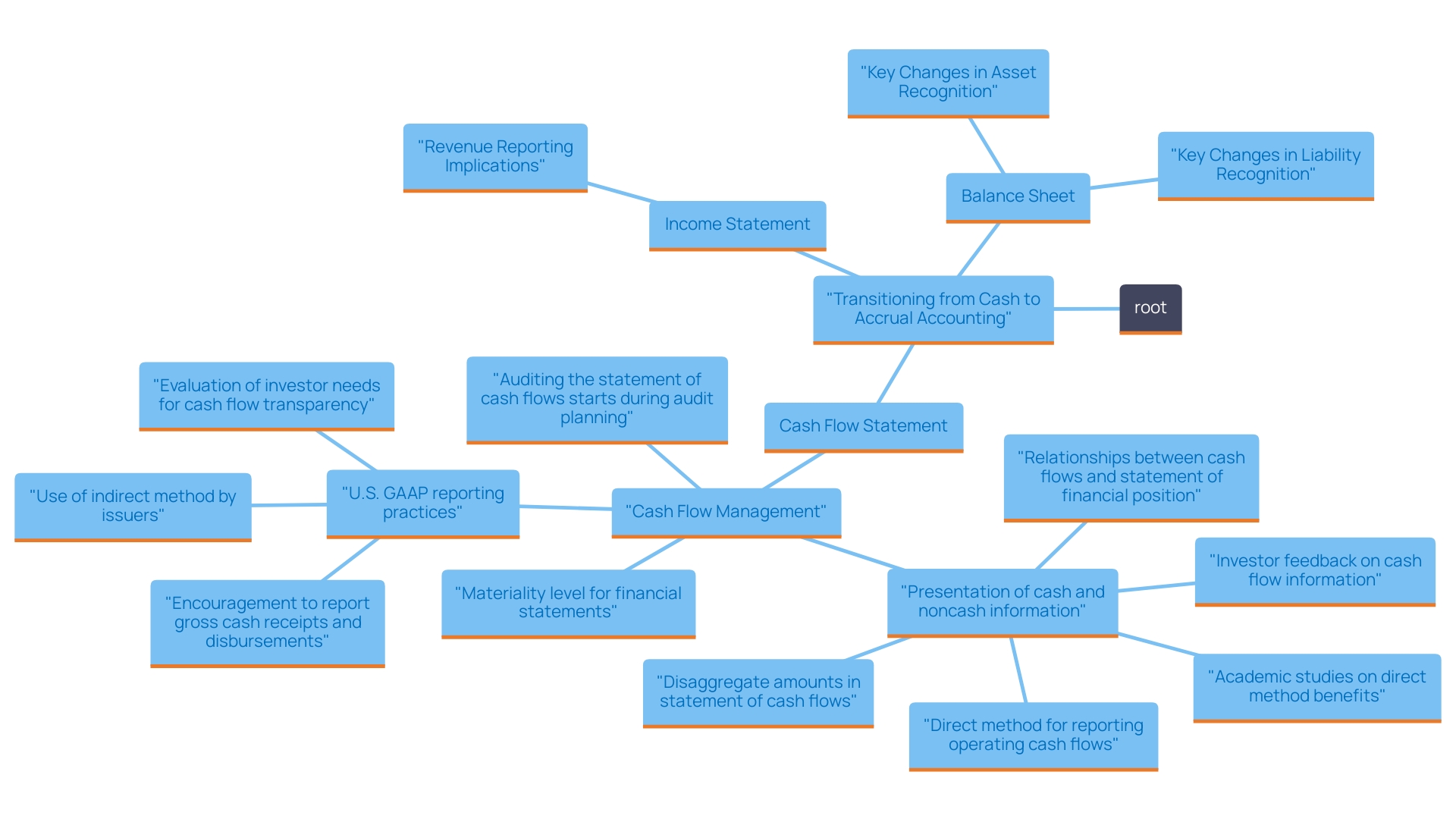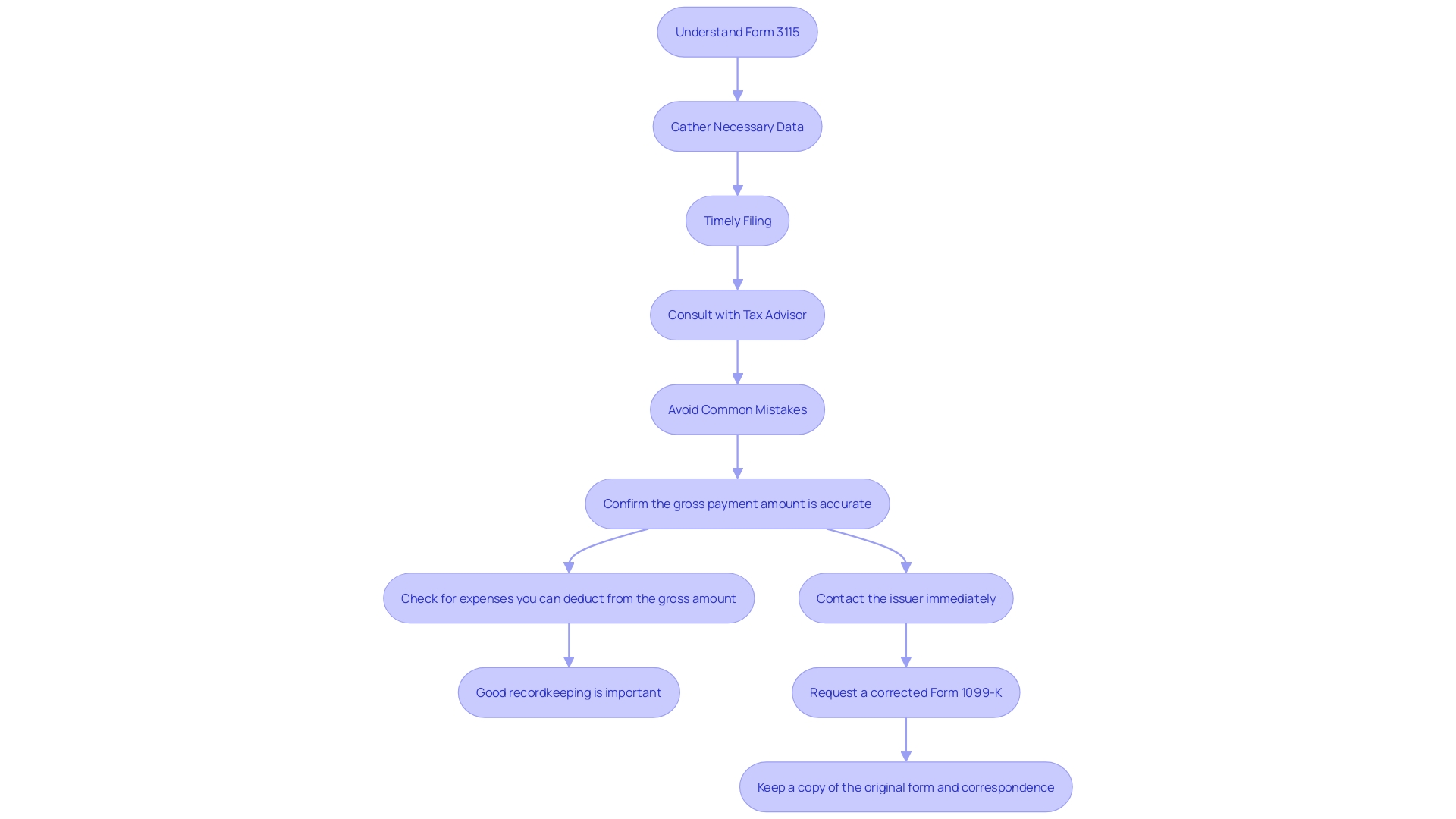Introduction
Transitioning from cash to accrual accounting is more than just a change in method; it's a pivotal shift that can redefine an organization’s financial landscape. As businesses strive for greater accuracy and strategic insight, understanding the nuances of these two accounting methods becomes crucial. While cash accounting offers simplicity, accrual accounting provides a comprehensive view of financial health, enabling informed decision-making that aligns with long-term goals.
This article delves into the essential steps, key adjustments, and regulatory requirements necessary for a successful conversion, equipping CFOs with the knowledge to navigate this complex process effectively. By embracing accrual accounting, organizations can enhance financial reporting accuracy, optimize cash flow, and ultimately drive sustainable growth.
Understanding Cash vs. Accrual Accounting Methods
Money-based record keeping simplifies budget management by acknowledging revenue and costs only when money is exchanged. This straightforward method is appealing for its ease of tracking. However, recognition-based bookkeeping, which logs revenues and expenses when they occur—irrespective of cash flow—provides a more detailed perspective on a business's economic well-being. By integrating receivables and payables, the system allows businesses to align their financial reporting with actual performance and obligations, ultimately enhancing strategic planning and decision-making.
Recognizing these differences is crucial for CFOs, especially during periods of crisis or organizational restructuring. Shifting to the method of recording revenues and expenses when they are earned and incurred can present substantial difficulties, as numerous companies may not be sufficiently equipped for the complexities involved. For instance, recent statistics indicate that approximately 60% of businesses transitioning to accrual practices in 2024 faced difficulties due to a lack of understanding of the method, underscoring the need for thorough preparation and education.
As pointed out by finance expert Jane Smith, "Comprehending both bookkeeping methods is crucial for CFOs to make informed choices in a swiftly evolving economic environment." To further enhance economic health and performance, CFOs can refer to the whitepaper 'Mastering the Cash Conversion Cycle: 20 Strategies for Optimal Business Performance,' which provides actionable insights on optimizing cash flow and profitability. This whitepaper details particular strategies, such as enhancing inventory management and optimizing accounts receivable, that can assist in the shift to accrual-based financial reporting.
The PULSAR Program has been crucial in promoting reforms that enhance reporting frameworks, further underscoring the significance of effective practices in adapting to changing environments. By incorporating insights from both the whitepaper and initiatives like PULSAR, CFOs can more effectively manage the intricacies of monetary versus earned revenue, ensuring precise financial reporting and informed decision-making.

Step-by-Step Guide to Cash to Accrual Conversion
-
Assess Current Financial Practices: Begin by thoroughly reviewing your existing cash management practices. Identify any gaps that could hinder a smooth transition to accrual financial reporting. This assessment lays the groundwork for understanding necessary adjustments.
-
Prepare Financial Statements: Generate up-to-date financial statements, including a balance sheet and an income statement, which will serve as your baseline for the conversion process. These documents are essential for comparing pre- and post-conversion results.
-
Identify Revenue Recognition Timing: Accrual accounting requires a shift in how revenue is recognized. Precisely determine when revenue should be recorded, aligning it with the delivery of goods or services rather than cash receipts.
-
Adjust for Accounts Receivable: Record any outstanding invoices that have been issued but not yet paid. This step ensures that all revenue is accurately reflected in your financial statements, enhancing the reliability of your reports. Consider implementing strategies from our whitepaper, 'Mastering the Cash Conversion Cycle,' which include effective methods to expedite accounts receivable collections.
-
Account for Accrued Expenses: Identify and record any expenses that have been incurred but not yet paid, such as salaries, utility bills, or other operational costs. Recognizing these expenses is vital for an accurate representation of your liabilities.
-
Implement Software Modifications: Assess your existing financial software to ensure it accommodates accrued entries. Make necessary adjustments to settings or think about upgrading to a more robust solution that can manage the intricacies of financial reporting. Leverage technology and automation, as suggested in our whitepaper, to enhance efficiency during this transition.
-
Review and Finalize Fiscal Statements: After making all adjustments, create new fiscal reports that reflect the revenue recognition method. This documentation will be essential for stakeholders to comprehend the organization’s financial health under the new financial reporting system.
-
Train Staff: Conduct comprehensive training sessions for your finance team to ensure they understand the subtleties of revenue recognition. This investment in education will facilitate a smoother transition and ongoing adherence to the new financial practices. Encouraging your team to utilize practical tips from our whitepaper can further enhance their understanding.
Effective transitions require diligence and attention to detail. Statistics suggest that companies that effectively shift from cash to revenue recognition observe an enhancement in reporting precision by as much as 30%. As Kiley Arnold, CPA, advises, 'Start by creating an annual operating budget template that can be rolled forward with updated revenue and expense estimates each year.' Furthermore, take into account the situation of Seven Peaks Software, which stated that implementing accrual-based methods assisted in simplifying their monetary processes and greatly improved their project success rates. This strategic planning is instrumental in adapting to the accumulation method and aligning financial practices with your organization’s goals.

Key Adjustments Required for Successful Conversion
When transitioning from cash to accrual methods, several critical adjustments must be meticulously addressed to ensure a smooth conversion process.
-
Add Accrued Expenses: Accrued expenses represent costs that have been incurred but not yet disbursed. For instance, if salaries are owed at the month's end but paid in the subsequent month, these expenses must be recorded in the current accounting period. This adjustment is essential as it accurately reflects the company's monetary obligations and provides a true picture of its economic health. Statistics indicate that failure to account for accrued expenses can result in a misrepresentation of economic health, affecting decision-making and investor confidence.
-
Adjust Accounts Receivable: It is crucial to recognize any sales made on credit during this conversion. Outstanding invoices need to be documented as assets, ensuring that revenue is not understated. This adjustment plays a significant role in presenting a more precise economic position, particularly for businesses with substantial credit sales. For example, a case study involving a mid-sized retailer showed that proper adjustment of accounts receivable led to a 20% increase in reported revenue during their first accrual reporting period.
-
Review Deferred Revenues: Cash received for services yet to be delivered must be adjusted to reflect a liability. This adjustment is essential to adhere to the revenue recognition principle, ensuring that the statements accurately depict the company’s obligations. Recent studies have indicated that companies that overlook this adjustment often encounter compliance risks and inaccuracies in their reporting.
-
Inventory Adjustments: Ensure that inventory is accurately recorded as an asset on the balance sheet according to the accrual basis of accounting. This involves reflecting the cost of goods sold appropriately, which is pivotal for calculating profitability and assessing overall business performance. In practice, businesses that accurately adjust inventory have reported a 15% improvement in their gross margin as a result of better inventory management practices.
Implementing these adjustments not only enhances the reliability of reporting but also aligns with best practices in management. As highlighted by industry experts, 'Accrued expenses are a foundational element in the accurate representation of a company’s statements.' By paying careful attention to these areas, CFOs can facilitate a successful transition and maintain the integrity of their reporting.

Impact of Conversion on Financial Statements
The shift from cash to accrual accounting presents significant implications across various statements, which are critical for understanding an organization's economic health and enhancing cash flow and profitability. This aligns with the insights provided in our whitepaper, 'Mastering the Cash Conversion Cycle: 20 Strategies for Optimal Business Performance.'
-
Balance Sheet: One of the most notable changes will be an increase in assets, particularly due to the recognition of accounts receivable. This adjustment reflects revenue that has been earned but not yet collected, a key factor in optimizing the Cash Conversion Cycle. Conversely, liabilities may also increase as accrued expenses are acknowledged, which can change the overall economic position of the company. Increased liabilities can indicate a higher level of short-term obligations, potentially impacting liquidity ratios and the company’s ability to meet its short-term financial commitments.
-
Income Statement: The income statement will now indicate revenue in the period it is earned instead of when funds are received. This change can result in variations in reported earnings, as companies may display higher revenues in periods when sales occur but payments haven’t been received yet. Matthew Friend, Executive Vice President and Chief Financial Officer of NIKE, Inc., emphasizes the importance of these adjustments by stating, 'We are driving better balance across our portfolio.' This statement underscores the need for accurate earnings representation to support sustainable growth strategies, a principle echoed in our whitepaper's strategies for enhancing financial health.
-
Cash Flow Statement: The flow statement will exhibit discrepancies compared to previous iterations, as it will now focus on actual movements instead of projected revenues and expenses. For instance, CFOs need to be aware that funds outflows for accrued expenses will be recorded when the liabilities are settled, rather than when the expenses are incurred. This distinction is crucial for accurately anticipating cash requirements and managing operational liquidity effectively, which is a core element of mastering the Cash Conversion Cycle.
Comprehending these changes is essential for economic analysis and strategic planning. As observed in NIKE’s recent restructuring efforts, which incurred $379 million in charges but still resulted in increased net income, effective management of these financial transitions can lead to sustainable, profitable growth. This highlights the importance of navigating the complexities of financial statement conversions to maintain clarity and investor confidence, reinforcing the actionable insights provided in our whitepaper.

Navigating Regulatory Requirements: Form 3115 and Beyond
In the United States, businesses intending to change their accounting method must file Form 3115, the application for change in accounting method. Here are the essential steps to effectively navigate this requirement while ensuring cash preservation and reducing liabilities:
-
Understand the Form: Familiarize yourself with the purpose of Form 3115, which is critical for documenting the change and ensuring compliance with IRS regulations. This understanding is vital for maintaining economic efficiency.
-
Complete the Form: Gather all necessary monetary data accurately before filling out the form. This encompasses previous financial methods, current practices, and details pertinent to the new approach. Proper documentation is key to minimizing potential liabilities.
-
File Timely: Submit Form 3115 within the designated timeframe to avoid penalties. Generally, it is due by the tax return deadline for the year in which the change takes place, highlighting the significance of prompt action in managing resources.
-
Consult with a Tax Advisor: Given the complexities surrounding financial method changes, enlisting a tax advisor can be invaluable. They provide tailored advice to ensure compliance while addressing specific concerns unique to your business situation. This aligns with the thorough monetary review needed to identify opportunities for cash preservation.
-
Avoid Common Mistakes: Be aware of common pitfalls in completing Form 3115, such as failing to include all necessary documentation or misunderstanding the nuances of method changes. Errors can result in delays or complications, affecting your economic efficiency.
Filing Form 3115 is a vital step in transitioning from cash to accrual methods. With increasing scrutiny from the IRS and the complexities involved, a proactive approach to understanding and completing this form will help safeguard your business against future regulatory challenges. Notably, the IRS has recently requested comments on whether the $500 safe-harbor threshold for certain capital expenses should be raised, which could significantly impact how businesses approach deductions. As Path has noted, "If a taxpayer can't be sure whether he has a supportable 481(a) adjustment, then how can the taxpayer file Form 3115?" This underscores the need for clarity and support in your accounting methods, ensuring financial efficiency and risk mitigation to uncover hidden value.

Conclusion
Transitioning from cash to accrual accounting is a strategic move that can transform an organization’s financial management and reporting. By understanding the fundamental differences between these two methods, CFOs can make informed decisions that enhance financial accuracy and align with long-term objectives. The step-by-step guide provided outlines essential actions, from assessing current practices to implementing necessary software changes, ensuring a structured approach to this complex process.
Key adjustments, such as accounting for accrued expenses and recognizing accounts receivable, are critical for a successful conversion. These changes not only improve the accuracy of financial statements but also foster better strategic planning and resource allocation. The implications of this transition extend to all financial statements, influencing balance sheets, income statements, and cash flow analyses, thus requiring careful monitoring and management.
Navigating regulatory requirements, particularly the filing of Form 3115, is another crucial aspect of the conversion process. Understanding the nuances of this form and ensuring compliance will safeguard organizations against potential liabilities and enhance financial efficiency. By embracing accrual accounting, businesses position themselves for sustainable growth, improved cash flow management, and enhanced reporting accuracy, ultimately driving better decision-making and operational success.
Taking decisive action now will pave the way for a more robust financial future.




